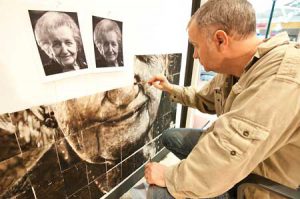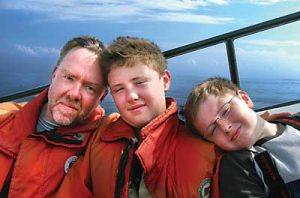
Former patient spearheads unique project to celebrate The Neuro
By Neale McDevitt
Two years ago, Yves Ferland was a man in desperate condition. A large tumour had been found on his frontal lobe during a routine x-ray following a tumble on the ski slopes. What he thought was a slight concussion turned out to be much more serious.
“It was growing rapidly and compressing my brain,” says Ferland. “I didn’t have any symptoms but I was probably just a month or so away from developing lesions on my brain.”
Just a few weeks after the terrifying discovery, Ferland found himself at the Montreal Neurological Institute (MNI) getting prepped for surgery. “It was February 15,” he says. “I remember it well.”
The surgery went off without a hitch. The tumour was removed and found to be benign. Ferland would have a full recovery and return to his normal life. Except for one small detail: “I fell in love with The Neuro and I fell in love with the wonderful people who work there.”
While still in the recovery room, Ferland made the decision to donate a certain percentage of his salary to The Neuro for the rest of his life. “I wanted to somehow repay my gratitude for being alive,” he says. But money wasn’t enough. He needed to do more.
Raising local awareness
Continuing his recovery back at home Ferland identified what he thought was one of The Neuro’s most pressing problems: little exposure, especially here in Quebec.
He drafted a questionnaire about The Neuro and sent it to some 200 friends, family members and acquaintances (“I had lots of time on my hands,” he laughs). What he found shocked him. “Almost no one had heard of The Neuro – especially among francophones,” he says. “Internationally this is a renowned hospital, but locally – nothing.”
Ferland contacted The Neuro’s External Affairs Office with a unique offer to raise the public’s awareness of the hospital by enlisting the help of some of Canada’s top visual artists in the creation of a permanent exhibit that would be housed in the MNI’s North Wing (which is currently under construction).
“We met with Yves and all he wanted to know was how he could help,” says Catherine Rowe, Executive Director, External Affairs Office, MNI. “When he told us about his idea we knew right away this was the right project for us.”
The Neuro from within
Drawing upon his experience in the art world (“In my previous life I studied art and had a small art-related business doing black and white printing for museums and artists”), Ferland recruited eleven top artists to “present to the public The Neuro from within,” through photography, painting and video.

During one meeting the group voted to include a twelfth artist – Ferland himself.
With a hard deadline in June to submit their respective work, the artists have become part of the furniture at The Neuro. “It’s pretty incredible to see,” says Rowe. “These are people who earn their living through their time and talent and they are donating so much of both to The Neuro.” A case in point: Steven Spazuk has spent all week at the Eaton Centre working on a large portrait of Brenda Milner – the Neuro’s renowned neuroscientist, using squares of cardboard, fire and soot (see photo, Page 1).
Although he hasn’t started his project, Ferland knows exactly what it will entail. “I’m going to take a picture inside the operating room where I had my surgery, from the operating table, to show what I saw before I was anesthetized,” says Ferland. “And I’ll be looking up at Dr. [Jeffrey] Hall and the crew who worked with me. The people who saved my life.”
